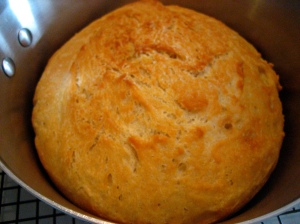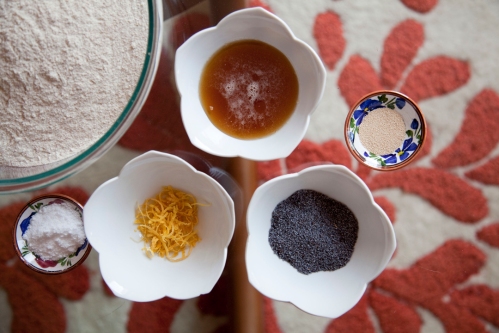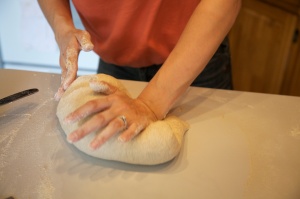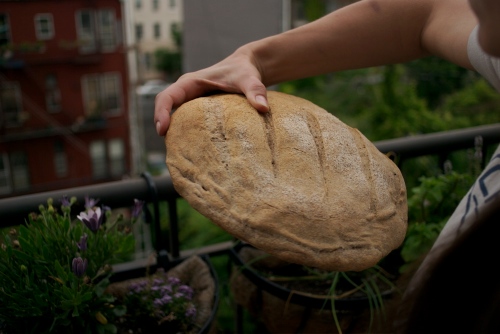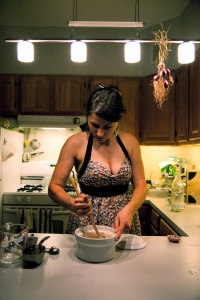
mixing the poolish before a party
I have a lot of friends here in Brooklyn. Actually, I have a lot of friends here in North Brooklyn. I think it’s pretty wonderful when feeding a friend’s cat over the weekend involves walking exactly one block. Some of these friends have blogs too, like Kenan, who had the genius idea of getting together a group of food and photo bloggers to create a big ole midsummer meal and, well, blog about it! We called it NBBB for North Brooklyn Bloggers’ Banquet.
For me this was good timing. Believe it or not, hardly anyone has actually tasted my bread. I frequently improvise meals for guests with confidence, but most of my loaves thus far have been barely edible! Now that I had a few success stories, it was time to share.
Emily planned to make a soup, in the tradition of her wild soup-night parties. She was deciding between a middle eastern and a mexican theme; I decided to follow her lead with my bread. (As a perfectionist, I’m loathe to mix themes in a meal!) I found two promising recipes in Bread Alone: 100% Whole Wheat Cumin Loaf and Country-Style Hearth Loaf with Cornmeal, Cilantro, and Coarse Pepper. I chose the latter when Emily went south of the border with Cold Avocado Corn Soup with Cilantro Oil.
Following the same process as my first Hearth Loaf, I mixed the poolish the night before. I nearly forget this vital step because I happened to be throwing a roof-top dance party. (Hence the dress!) Whisked together, the water, yeast, and flour went into the fridge. I set my alarm for 10am to bring the bubbling gruel back to room temperature.

emptying my beautiful new bread bowl, about to start kneading
Around 1pm on Sunday I got to work kneading. The added ingredients made this a fun dough. I measured every ingredient ahead of time (a rare feat for me), I ground pepper corns in a mortar (watch out, they pop!) and I chopped cilantro leaves (from an absurdly large bunch). I attempted to add a lot more flour during the knead but in retrospect I think I could have been even more generous.
Also around 1pm, Cate and Kenan arrived with grand plans. Cate was making an Almond Tart and Currant, Raspberry & Cherry Frozen Yogurt; Kenan documented our exploits with sketches. Cate has a bit of bread experience herself and helped me knead.
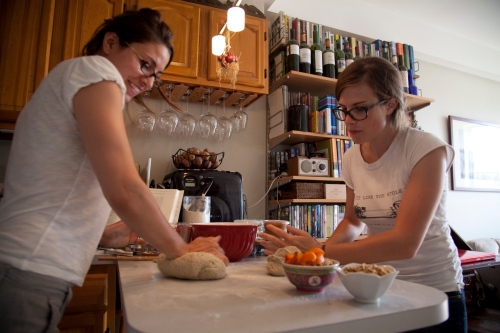
Cate and I kneading together
Sunday was hot. Not an ideal environment for baking bread…nor for hangovers! (And not for sick husbands either – I prescribed air-conditioned bed-rest to poor Joe, who had a bad cold.) The heat does encourage rising dough. Technically a faster rise develops a less flavorful bread, but I had already fermented a very long poolish at a low temperature, and welcomed a fool-proof rise. But I wasn’t looking forward to turning on the oven. Mere sunlight is enough to bring my apartment into the high 80s. So while my bread rose, and Cate slaved away at dessert, I lay on the couch with a water bottle. Emily arrived to start on the soup in the late afternoon.

- NBBB
Around 6pm, the rest of the banqueteers arrived, and chaos ensued. There were no less than 5 cooks in my 10ft x 8ft kitchen, plus 3 photographers. For some reason we never turned on the A/C, and it was definitively over 90 degrees in there! But thanks to our sweaty work, Dory, Jake and Tanveer whipped up three more incredible dishes: Watermelon, Tomato, and Goat Feta Salad, Shell Bean and String Bean Ragout, and Squash Curry Stew. Along with the soup and the dessert, it was an exquisite meal.

- The North Brooklyn Bloggers
This bread came out very well – right on par with my previous loaf. My crumb and crusts have become pleasantly chewey, I had good oven spring, and the crumb is even (generally a positive trait). I enjoyed the added flavorings but couldn’t taste much more than the pepper! A full tablespoon per loaf is a lot of pepper. These were actually spicy! Next time I try this recipe I plan to cut way back on the pepper and possibly even increase the cilantro. My other plan (for any loaf) is to add more flour during the kneading process. Once again, my loaves spread during proofing. I think I need to give my dough a little more backbone. Luckily I have an excuse to practice – Caroline’s Restoration Farm potluck is right around the corner!


